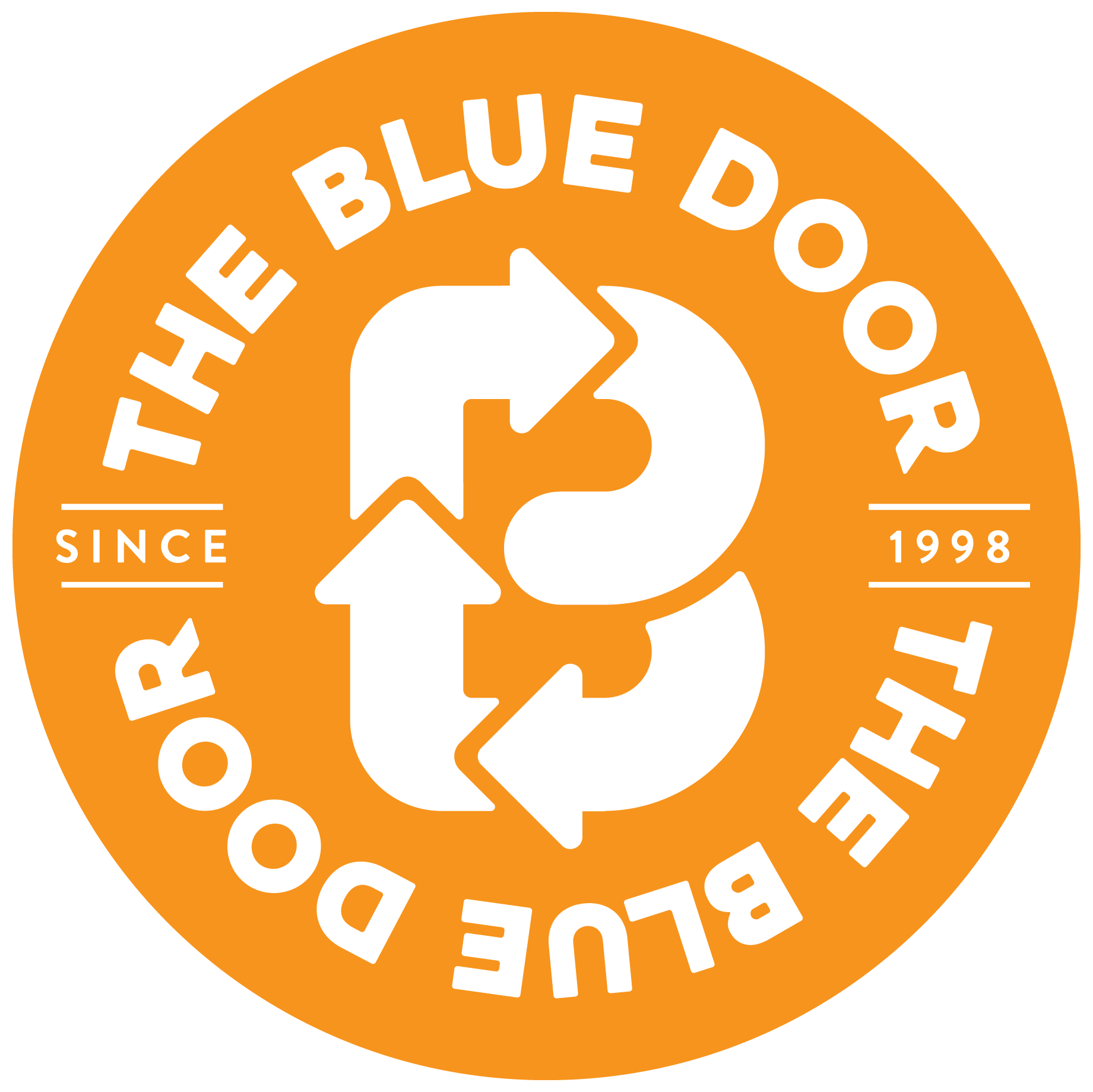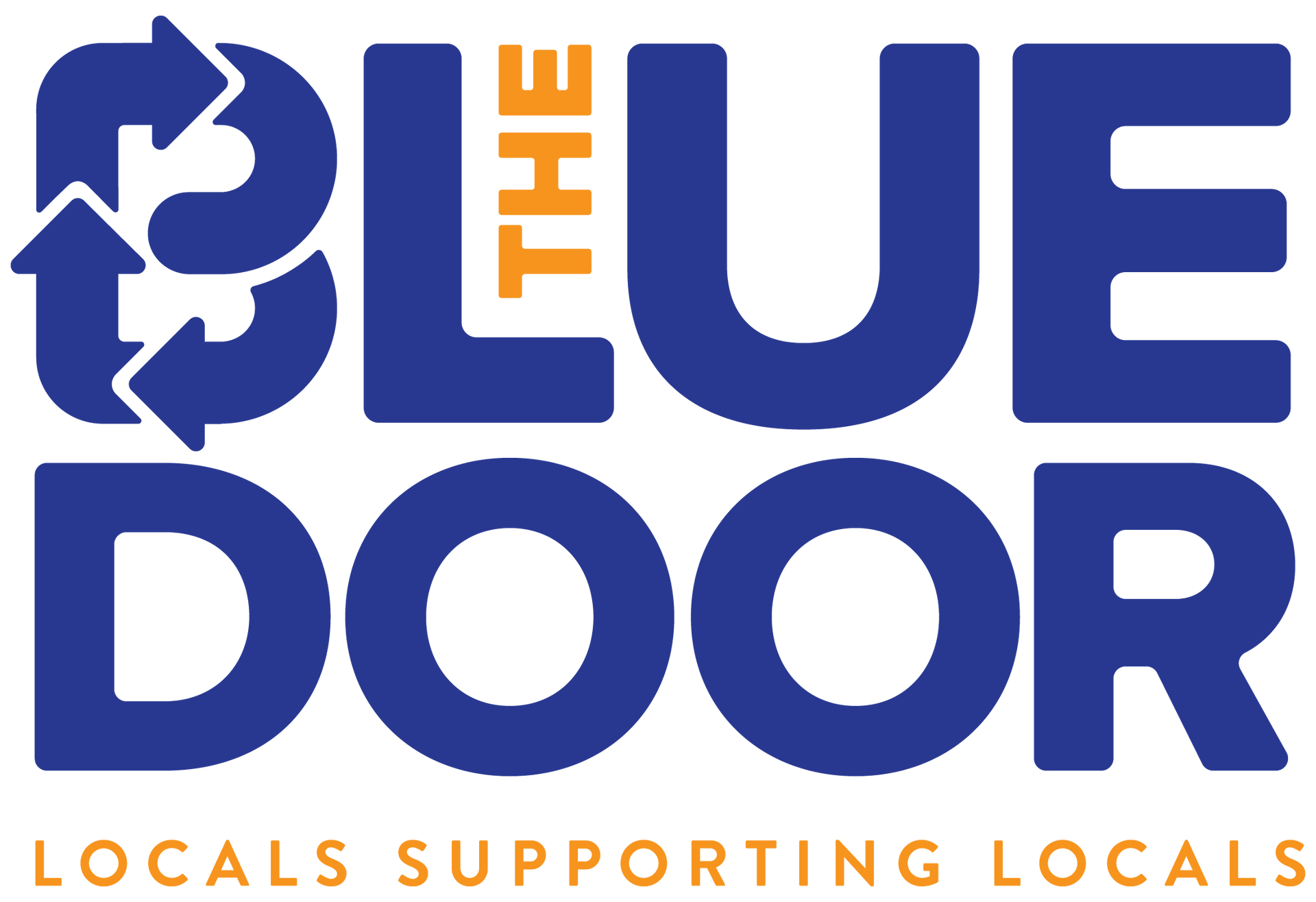How The Blue Door Came Into Existence (contributed by Beverley Kingston)
In 1992 I began a 50c market at Nativity Church because I was aware that people were throwing away small but useful items. At the same time, I was working alongside the Council as a Recycling Officer, concentrating on encouraging firms to take their cardboard to be recycled rather than dumping it. One lunch time I was walking along the street on my way to Community Worker meeting when a friend stopped and asked in a serendipitous moment “What are you up to these days?” I explained that I had just been at the tip and seen practically no cardboard, meaning it was being recycled. Her reply was “don’t worry about the cardboard, it is all those good sofas being dumped that worries me.” When I arrived at the meeting the speaker had not turned up so it was decided that we would go round the room and each group representative would outline the biggest problem facing their group, but we were not to mention money or the lack thereof. The spokesperson for Prisoner’s Aid said their problem was the lack of furniture. People left prison but by the time they had paid their rent and rent in advance they had no money. Birthright had the very same problem. So, the meeting ended with us agreeing that we needed somewhere to stash the sofas etc. that we knew were being dumped. It took us a while to find somewhere suitable. Someone found a double garage where the cars parked one behind the other. I vetoed that idea saying I did not want to work where the first customer wanted a sofa and there was a cot and a double bed in front of it. In 1993 we found a building to rent. It belonged to Cuddons and was just near The Boathouse Theatre. I shifted my 50c market there and what we were going to call Marlborough Community Furniture Market became Over The Tracks Market as that helped people find us.
We had a small committee and we just sat around and discussed what we needed to do and then we did it. I do not think we ever kept a record of these meetings. Ron Hester and Tup Johnstone volunteered to serve in the shop which was open two mornings a week and other times on request. For example, one morning a young mother came in as she had an option to rent a flat but wanted to be sure she had two beds and a chair. We arranged for her to come back in the afternoon by which time she had secured the flat and brought a friend to take away the furniture she bought.
We were hoping to eventually use our earnings to fund a night shelter but the police would not have a bar of this so we decided that hot dinners might the next best thing but before we could get this underway John’s Kitchen began so we gave them a grant. Cuddons notified us that they needed their building back, so the hunt was on to find a suitable place to go. A building to rent was located not far away in Horton Street but we missed out on that as I was not prepared to sign a lease for more than a year. Someone else signed up for five years. Ironically, they left after six months.
In the end we found a suitable building at 33 Grove Road. Ideal. Parking out the back, big windows facing the street. I went home and said to Allan “We have found the perfect building. The only thing is we will have to open every morning to make the rent”. Allan said, “Could you please say that again” and I knew he was not enthusiastic about having a working wife. (He was retired by this time). So, in 1996 we handed the whole thing over to another community group to run. I paid the rent for them for two weeks, worked alongside them for a week and was present to provide support for the second week but it fell over. They put in paid employees, had the phone installed – ran before they could walk. The Committee agreed that we would keep $5000 in the bank in case we wanted to start something else and from memory I think we gave the rest to the Community Food Bank.
A year or so later The Express published an article about recycling and mentioned that since “Over The Tracks market” closed people were doing without furniture etc. The following Sunday in church Warwick Hearne mentioned that the church office had had several requests for blankets etc. and wouldn’t it be nice if we could supply these needs. After the service several people spoke to Warwick about his idea. The first one had a trailer load of carpet she would like to donate, the second one had read the article in the paper and was keen to help distribute the goods and I said “Warwick, where do you think we are going to store this stuff? We need a shop.” That week we found a sample room in Auckland Street, and we agreed to rent it for $34 a week. Anne Bowen, who had volunteered to distribute goods, agreed that she would work in the shop and Tup Johnstone from Over The Tracks Market was keen to help too. I wanted to call the shop “Anne’s Place”, but she would not agree to that, so we called it “The Blue Door” because it had a blue door. I did not want to call it “The Secondhand Shop”. We were open two mornings a week and trade soon built up and we were able to return the $5000 we had borrowed. Soon we rented the sample room next door and Donna Burgess became our third volunteer.
One day I arrived at lunchtime to collect the takings to do the banking and set up for the next day’s trading to find that someone had donated us a double bed and the shop was so full we could scarcely find a place to put it. Time to look for a bigger building I thought. On the way to the bank, I passed Levins old building on the corner of Alfred and Grove Road. On the window was a sign “To Rent - Phone ………”. I went home, phoned up and the building was ours. The Lions helped us shift in. We appointed a shop manager, Sandra Kirk, our first paid employee.
Business was brisk but stock was low so every Friday I went to the weekly auction. Anything cheap I snapped up. My rule was that if I could not sell it for double what I paid for it then I did not buy it. We bought a handcart, and every Friday Bob Mullins would turn up, load the cart with the things I had bought wheel it down the ramp and around the corner to our shop.
Presently our building was up for sale and the new owner had a use for it – he was not wanting to rent it out so the hunt for new premises was on. We wanted to stay in the town centre but were aware that not everyone wants a secondhand shop next to them. Finally, we found a building in Charles Street. When the owner asked what I was going to do with it I said “sell secondhand gear” he quickly informed me that someone else was interested in the building. I let the matter lie for a week then approached the owner again intimating that we could pay a year’s rent in advance. “Sign here” was his response.
The building was in two parts and soon after we shifted in, the tenants in the back section left and so we were able to expand our recycling. The council came on board at this stage. They advertised as expressions of interest to run a recycling centre and we were chosen. To sign a three-year contract, we had to become an Incorporated Society with an A.G.M. and meetings at which minutes were taken. Beryl Nelson became the treasurer, and we used an accountant to do the P.A.Y.E. We had always recycled but now we were able to operate on a much bigger scale. We collected steel cans, aluminium cans, soft drink bottles and milk bottles. Lester Holdaway acquired an old wool press which he modified for us, and which Jim Hammond ferried from Seddon to Lester’s and then to Charles Street for us. Doug Dean and his team came once a week and baled our plastic, and the bales were taken to Christchurch by Linfox once they had delivered groceries to Countdown. At the end of three years, we did not renew our contract as we did not have enough space, and a new press which we would have needed was more than $60,000. So, our recycling centre was taken over by the council and they built the Resource Recovery Centre in wither Road for this purpose.
The shop went from strength to strength. More volunteers joined, then an assistant manager was appointed, and I left as I could see it could manage without me. One morning when we still in Auckland Street we made $60, and I thought we were on our way. Little did I know then how far it would go.
When we became an incorporated society Graham Fuller became involved and he found Sue Duckworth to join us. That is when we began community grants. I remember a kindergarten applied for a grant to buy a doll’s pram and they subsequently sent us a photo of two little girls pushing the prams and smiling.
Some people who had been helped by the Blue Door wanted to pay back by becoming volunteers in the shop so gradually the Nativity folk were joined by others, but Nativity had most seats on the Board.
Since I left there has been one more shift in March of 2014 – to Seymour Street, a high- profile spot on a main road close to Countdown, and the bus stop. This has proved to be a very good move. The shop continues to provide goods at reasonable prices and to help community groups, so it is a win all round.

